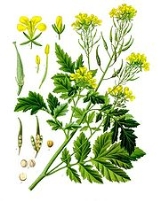
White Mustard
Encyclopedia
- "Yellow mustard" redirects here. For information on the condiment yellow mustard, also known as "American mustard" (such as French's yellow mustard), see Mustard (condiment)#Yellow mustard.
White mustard (Sinapis alba) is an annual plant
Annual plant
An annual plant is a plant that usually germinates, flowers, and dies in a year or season. True annuals will only live longer than a year if they are prevented from setting seed...
of the family Brassicaceae
Brassicaceae
Brassicaceae, a medium sized and economically important family of flowering plants , are informally known as the mustards, mustard flowers, the crucifers or the cabbage family....
. It is sometimes also referred to as Brassica alba or B. hirta. Grown for its seeds, mustard
Mustard (condiment)
Mustard is a condiment made from the seeds of a mustard plant...
, as fodder crop or as a green manure, it is now widespread worldwide, although it probably originated in the Mediterranean region.
Culinary uses
The yellow flowers of the plant produce hairy seed pods, with each pod containing roughly a half dozen seeds. These seeds are harvested just prior to the pods becoming ripe and bursting.White mustard seeds are hard round seeds, usually around 1 to 1.5 millimetres in diameter, with a color ranging from beige or yellow to light brown. They can be used whole for pickling or toasted for use in dishes. When ground and mixed with other ingredients, a paste or more standard condiment
Condiment
A condiment is an edible substance, such as sauce or seasoning, added to food to impart a particular flavor, enhance its flavor, or in some cultures, to complement the dish. Many condiments are available packaged in single-serving sachets , like mustard or ketchup, particularly when supplied with...
can be produced.
The seeds contain sinalbin
Sinalbin
Sinalbin is a glucosinolate found in the seeds of white mustard, Sinapis alba, and in many wild plant species. In contrast to mustard from black mustard seeds which contain sinigrin, mustard from white mustard seeds has only a weakly pungent taste.The less sharp taste is because the mustard oil...
, which is a thioglycoside responsible for their pungent taste. White mustard has fewer volatile oils and the flavor is considered to be milder than that produced by black mustard seeds.
In Greece, the plant's leaves can be eaten during the winter, before it blooms. Greeks call it vrouves or lapsana.
The blooming season of this plant (February-March) is celebrated with the Mustard Festival, a series of festivities in the Wine Country of California (Napa and Sonoma counties).
External links
- http://www.maltawildplants.com/CRUC/Sinapis_alba.php Comprehensive profile for Sinapis alba.
- Sinapis alba Flowers in Israel
- http://mustardfestival.org

